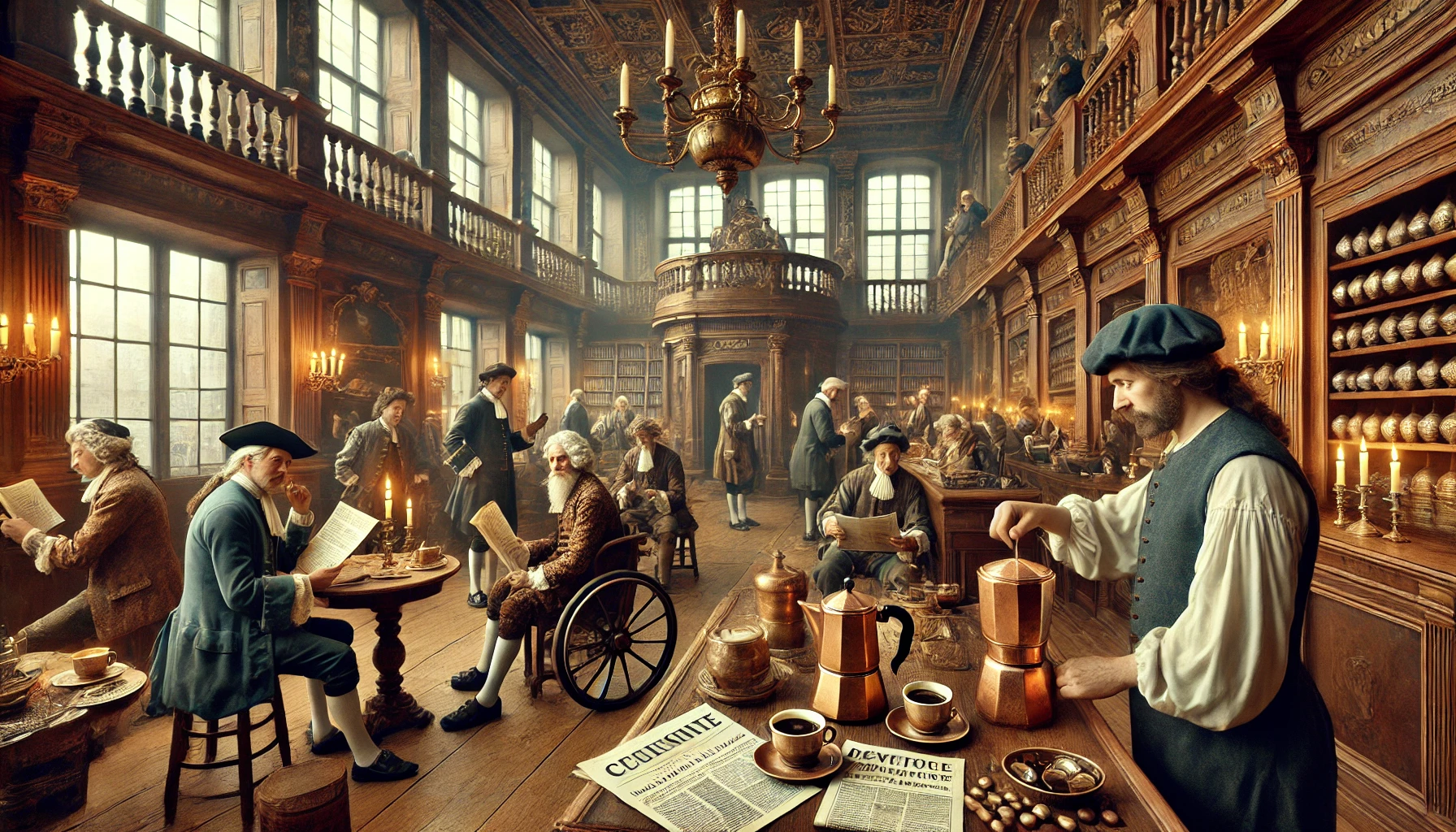Long before cafés became modern symbols of comfort and creativity, they served as engines of transformation in 17th-century Europe. Coffeehouses were radical spaces—fueling enlightenment, economic change, political discourse, and cultural revolution. As the coffee bean traveled from the Islamic world to European cities, it brought with it a social custom that would change the continent forever. In this article, we’ll explore the rise of European coffeehouses and their profound impact on society.
Coffee’s Arrival in Europe: A Curious Brew
Coffee arrived in Europe through two main channels: Venetian traders and Ottoman connections. By the early 1600s, merchants had begun importing coffee from the Middle East, and curious Europeans were eager to try this exotic new beverage. Its unique bitter flavor and energizing effect sparked both fascination and suspicion.
Initially, coffee was sold by apothecaries and considered a medicinal product. Some believed it cured ailments ranging from headaches to digestion issues. But as demand grew, coffee evolved from a niche remedy into a fashionable drink, especially among the upper classes.
The First European Coffeehouse: Venice, 1645
The very first European coffeehouse opened in Venice in 1645. Known for its vibrant trade networks and cosmopolitan spirit, Venice was the ideal place for coffee to debut. The café offered a space where merchants, sailors, and aristocrats could gather and enjoy freshly brewed coffee in an elegant setting.
The Venetian model was soon copied across Italy, and by the late 1600s, coffeehouses had become an urban phenomenon in major European cities like London, Paris, and Vienna.
England’s “Penny Universities”
Perhaps no country embraced the coffeehouse quite like England. The first English coffeehouse opened in Oxford in 1650, followed by another in London in 1652. Quickly, coffeehouses became central to English intellectual and commercial life.
The nickname “penny universities” emerged because, for the price of one penny (the cost of a cup of coffee), a person could gain access to discussions, debates, and newspapers—essentially, an informal education.
These coffeehouses were frequented by thinkers, writers, merchants, and students. People from various walks of life came together to share ideas, challenge opinions, and learn about world events. They were incubators of change and knowledge.
Parisian Cafés and the Age of Enlightenment
France followed closely behind England in embracing coffee culture. The first café in Paris opened in 1686—the famed Café Procope. It quickly became a hotspot for philosophers, artists, and revolutionaries. Voltaire, Rousseau, and Diderot were known patrons, sipping coffee while shaping the intellectual foundations of the Age of Enlightenment.
Parisian cafés differed from English coffeehouses in their elegance and artistic spirit. They were more refined, often decorated with mirrors, chandeliers, and plush seating. Here, coffee was not just fuel for conversation—it was part of the performance of high culture.
Coffee and the Rise of Print Media
One of the lesser-known effects of the coffeehouse revolution was its impact on journalism and print media. Coffeehouses became natural distribution points for pamphlets, newspapers, and political tracts.
In London, for example, many coffeehouses developed their own subscriber lists and in-house newspapers. Patrons would gather daily to read the news aloud or engage in fiery discussions about politics and philosophy.
This connection between coffeehouses and information helped spark the development of modern journalism and transformed public opinion into a powerful force.
Vienna: A Coffee Capital with a Unique Flavor
The story of coffee in Vienna is tied to war and legend. After the failed Ottoman siege of Vienna in 1683, the retreating forces left behind sacks of strange, dark beans. A Polish military officer named Jerzy Franciszek Kulczycki recognized them as coffee and opened Vienna’s first coffeehouse.
Viennese cafés soon became known for their distinctive presentation—coffee served with milk, sugar, and pastries in ornate cups. The tradition of pairing coffee with sweet treats (like Sachertorte or Apfelstrudel) became a staple of Austrian culture.
Vienna’s coffeehouses also developed a reputation for quiet contemplation, literary activity, and political dialogue. Writers like Stefan Zweig and Sigmund Freud made these cafés their second homes.
Social Change and Inclusion
In 17th-century Europe, coffeehouses were unusual in their inclusivity. While taverns were often male-only and associated with alcohol, coffeehouses allowed for more civilized, sober discussion. They attracted professionals, merchants, artists, and scholars.
Though women were not always welcome in these spaces—particularly in England—many European cities began opening more inclusive coffeehouses by the 18th century, especially in Paris and Vienna. Over time, cafés became vital centers of both male and female intellectual life.
Coffee and Political Movements
Coffeehouses were more than cultural salons—they were breeding grounds for political unrest and change. In England, coffeehouses became associated with Whig politics and the rise of parliamentary power. The monarchy grew suspicious of them, and at times, efforts were made to shut them down.
In France, cafés played a crucial role in fomenting revolutionary ideas. The French Revolution itself is said to have been born in the cafés of Paris, where citizens debated the nature of government, liberty, and justice.
Even in the American colonies, the Boston Tea Party was followed by a coffee surge, with patriots choosing coffee over tea as a symbol of rebellion.
Coffee’s Role in Business and Finance
Many of today’s most powerful institutions can trace their origins to European coffeehouses. In London, Lloyd’s Coffee House became the foundation for Lloyd’s of London, the global insurance giant. The London Stock Exchange also had its roots in coffeehouse culture, where merchants met to trade goods and information.
Coffeehouses helped develop the idea of public commercial space, where deals could be made over a hot drink, and trust was built through conversation.
The Coffeehouse Legacy Today
Although today’s cafés look different, their DNA traces back to the coffeehouses of 17th-century Europe. The idea that coffee is not just a drink, but a vehicle for ideas, community, and culture, remains intact.
From co-working cafés to political roundtables held in coffee shops, the spaces that emerged centuries ago continue to thrive and evolve. They are symbols of open conversation and democratic ideals.
Conclusion: Coffee’s Revolutionary Spirit
The rise of coffeehouses in 17th-century Europe shows how something as simple as a beverage can become a catalyst for profound change. Coffee didn’t just keep people awake—it woke them up to new ideas, connections, and ambitions.
As we sit in modern cafés, working on laptops or catching up with friends, we are participating in a tradition that has sparked revolutions, transformed economies, and reshaped the way people engage with the world.

